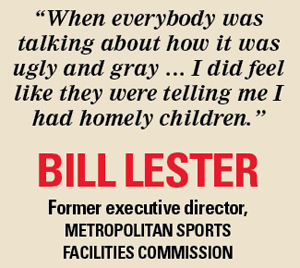
Bill Lester spent 25 years as executive director of the Metropolitan Sports Facilities Commission before retiring last summer. As head of the commission, Lester was in charge of the Hubert H. Humphrey Metrodome, a stadium criticized over the years for its design, but a versatile building that played host to Super Bowls, Final Fours and World Series. It’s a feat that will not be replicated in an age with so many sport-specific venues, Lester says.
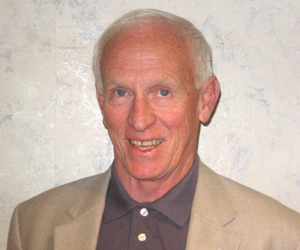 |
| All photos courtesy of Bill Lester |
■ How did you get started in the business?
Lester: Originally I was a teacher and a coach in high school. I ended up in Minnesota after graduating from a small college in Montana called Carroll College, a small Catholic school in Helena. I went into the seminary after I graduated. I was sent to St. John’s College in Hilton, Minn. I was a little slow … it took me two years to realize how serious they were about celibacy. Once it sunk in, I thought, “This is crazy, I can’t stick around.” I started teaching and coaching at a Catholic boys’ high school in St. Paul called Hill, now Hill-Murray. I did that for two years and then left education and worked at about four different jobs with [the
Metropolitan Council] planning and coordinating agency. Then left in 1987 to take over the commission.
■ What are some of your fondest memories of the Metrodome over those 25 years?
Lester: The outstanding memories that everybody has, the ’87 and ’91 World Series wins by the Twins and the ancillary events that occur with that. The welcome home after the Twins won the 1987 American League playoffs with Detroit. It was improbable. The Twins had only won 87 games, but they just happened to be blessed with being in the weakest division and then they got hot at the right time and you could still do it with two pitchers who happened to be aces. When we would win a championship in high school … you got the fire engine, you had a rally. With the Twins, it was 64,000 people in the Metrodome with no event, just welcoming home the team. That still is the most incredible event for me. It was a very worrisome night because people had been drinking all afternoon and we were trying to put together the security and a system that made sure we safeguarded the building and yet still celebrated a terrific event in the history of this community.
■ Tell us a few stories from behind the scenes that haven’t been told.
Lester: There was a pickpocket gang, three or four guys working the crowd at an NCAA game at the Metrodome. One guy would distract you, the other guy would pick your pocket. The first three victims came in and said it was “two guys wearing red sweaters.” That wasn’t a big help. It was Maryland against Ohio State or somebody like that. Everybody in the place was wearing a red sweater. I remember the cops saying, “You’re going to have to be a little more specific.”
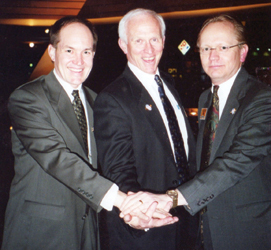 |
With the Metrodome’s Steve Maki and Dennis Alfton
|
We had some great pickup games where we would have front office people from the Twins and Vikes on the court when we hosted NCAA events. Those were a lot of fun. We played from 6 to 8 in the morning and called it “the testing of the floor.” We played one morning and Bill Hancock, the head of the NCAA at the time, had noticed that CBS had put their tower so that it blocked hundreds of seats, that you couldn’t tell until it was actually up there. This was about 6:30 in the morning and he said, “That’s going to be a big problem,” so we stopped the work crew right then rather than have them put the tower all the way up and then have to take it back down so we wouldn’t kill the seats. We were able to work it out, but if we hadn’t been playing basketball that morning ...
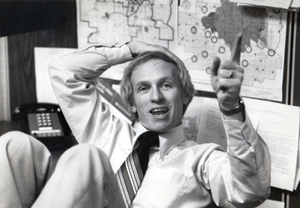 |
Lester during the Twins’ 1987 World Series appearance.
|
■ Where were you when the roof collapsed in December 2010?
Lester: I was actually on vacation, skiing in Colorado with a bunch of guys in Vail. I was on the phone with [Metrodome director of facilities and engineering] Steve Maki all the time because we had a game scheduled for that Sunday. [Starting with Friday’s initial roof damage] it was an incredible conflation of bad weather, high winds and incredibly freezing temperatures. We had conference calls with the NFL and the Vikings. Had a young guy from Bird-Air, manufacturer of the roof fabric, who said we won’t be able to play Sunday but we could play it Monday night; still looked like we were going to be fine. [Sunday morning], the phone rang at 4 a.m. Colorado time and Steve said, “We’ve lost the roof.” I got down off the mountain, took an early flight back to Minnesota and was back by noon local time to start assessing the damage.
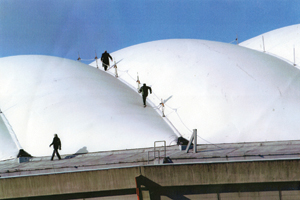 |
Lester leads a tour of the Metrodome’s roof, occasionally a newsmaker itself, in 2009.
|
■ Any truth to the story that the Vikings pumped artificial noise into the dome?
Lester: No. There were a few urban myths … and a little element of truth in there, too. With the Vikes, there was a sound person — to be charitable about it, he was a bit eccentric — and he could create even more sound or direct it at the bench of the opposing team. I can’t remember if it was the Rams or the Eagles, they couldn’t hear themselves think because of the size of those speakers and where they were positioned. That did precipitate some [new NFL] rules about where they could be, how close to the bench. They didn’t pump anything extra in. Red McCombs, when he was the owner, he liked to say it was the loudest stadium in the NFL. I think it was the combination of trying to throw off the other team. …
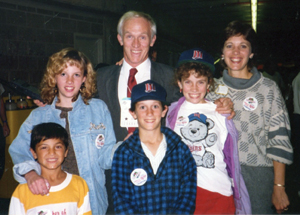 |
With family at the World Series in 1987
|
We also had [electrical] fans and blowers to keep the fabric roof in place. The fans would keep it inflated. There were huge cold air intakes to change air out at field level. In baseball, [opposing managers] Bobby Valentine and Billy Martin thought the Twins were somehow manipulating a ball. So if a Twins player hit a short infield popup it would be a home run to center field, and then they would reverse the [air flow] and Dave Kingman [for example] couldn’t hit it past the infield. The University of Minnesota did do an analysis, if you could actually manipulate, with any degree of scientific certainty … and you couldn’t. I always wanted to make sure we didn’t screw with the integrity of the game.
■ Looking back at the Metrodome as a multipurpose facility, how did you feel it influenced buildings today such as Cowboys Stadium?
Lester: I think it was a harbinger of what you could do because it wasn’t going to be successful, especially in Minnesota, to put that much public money into a facility if you weren’t getting some kind of a return out of it. We were able to use it for [public] roller blading in the concourses. Not that you could or should use modern buildings quite like that, like an enlarged community center, but it did set the stage where you could tell that story. If you asked a focus group today, they’d say yes … even if they had never been to a college baseball game there they would know we play hundreds of baseball games there in February and March. So the idea of making it versatile was definitely a legacy of the Metrodome. In the early days, when everybody was talking about how it was ugly and gray and there was too much concrete, I would get somewhat defensive. I did feel like they were telling me I had homely children. I overcame that because of the legacy, such as the multipurpose element and what it said about other facilities in other parts of the country, how you can make sure they become a relevant part of life in the community.
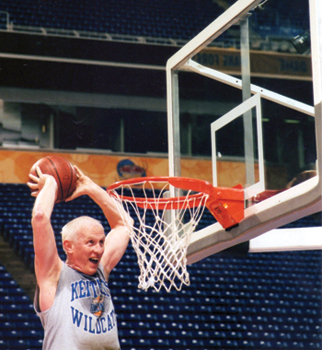 |
Clowning around at a Final Four pickup game
|
■ What have you been doing these days?
Lester: I had a consulting contract with the Minnesota Sports Facilities Authority that lasted six months. Then I’ve been doing some informal advice as they get ready for the new facility. Minneapolis and Minnesota would like to stay in the hunt for future NCAA events.
I’ve been traveling quite a bit, have grandkids on the East Coast and two in St. Paul. I’ll go to the Final Four. I still think that’s the primo event even though we had 25 years of great events.



